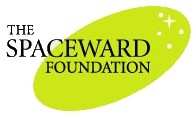NASA And Spaceward Foundation Award Prize Money For Successful
Wireless Power Demonstration
 NASA has awarded $900,000 in prize money to a Seattle company
that successfully demonstrated new wireless energy beaming
technology which could one day be used to help power a "space
elevator."
NASA has awarded $900,000 in prize money to a Seattle company
that successfully demonstrated new wireless energy beaming
technology which could one day be used to help power a "space
elevator."
LaserMotive of Seattle was awarded the money after its
performance in the Power Beaming Challenge competition, which was a
demonstration of wireless power transmission that enabled a robotic
device to climb a vertical cable. The competition was held Nov. 4-6
at NASA's Dryden Flight Research Center in Edwards, California. The
Spaceward Foundation of Mountain View, California, manages the
competition for NASA's Centennial Challenges program.
To win a prize, teams had to develop a power transmission system
and robotic climber that could reach a height of 3,280 feet. Teams
that reached the top share in a total purse of $2 million, based on
their vertical speed and payload mass.
LaserMotive's average speed on their best of several successful
climbs was 8.7 mph over a four minute period. By exceeding the
average speed of 4.5 mph and being the only team to reach the top
of the cable, LaserMotive claimed the entire $900,000 prize for
that level. Teams had to exceed an average speed of approximately
11 mph to qualify for a share of the remaining prize purse of $1.1
million. That amount will remain available for the next Power
Beaming competition.
NASA is interested in power-beaming technology for a variety of
purposes including remotely powering rovers and instruments on the
moon. On Earth, the technology might supply communities with power
following natural disasters. There also are potential applications
for power beaming for airships, satellites and space
transportation, including the space elevator concept.
LaserMotive was competing with two other teams, the Kansas City
Space Pirates and the USST team from South Bend, Indiana. Although
they did not post prize-winning performances, the other teams kept
the contest outcome in doubt up until the final moments.
 "I have watched these teams steadily improve their designs
since we began the challenge in 2005 and the sophistication of the
systems that they demonstrated this week is impressive by any
standard," said Ben Shelef of the Spaceward Foundation.
"I have watched these teams steadily improve their designs
since we began the challenge in 2005 and the sophistication of the
systems that they demonstrated this week is impressive by any
standard," said Ben Shelef of the Spaceward Foundation.
A vertical "racetrack" was created for the competition by
suspending a cable from a helicopter flying 4,300 feet overhead.
This arrangement, along with the high-power laser systems, provided
a unique and unprecedented testing environment.
"The kilometer-high vertical cable system established for this
competition was something that had never been done before and is a
remarkable accomplishment in itself. The Spaceward Foundation and
their partners, along with our hosts at NASA Dryden, deserve a lot
of credit for their creativity and determination," said Andrew
Petro, Centennial Challenge program manager.
The Power Beaming Challenge is one of six Centennial Challenges
managed by NASA's Innovative Partnership Program. NASA's Centennial
Challenges program's goals are to drive progress in aerospace
technology that is of value to NASA's missions; encourage
participation of independent teams, individual inventors, student
groups and private companies of all sizes in aerospace research and
development; and find innovative solutions to technical challenges
through competition and cooperation.
 ANN's Daily Aero-Term (04.28.24): Airport Marking Aids
ANN's Daily Aero-Term (04.28.24): Airport Marking Aids Aero-News: Quote of the Day (04.28.24)
Aero-News: Quote of the Day (04.28.24) ANN's Daily Aero-Linx (04.28.24)
ANN's Daily Aero-Linx (04.28.24) Aero-News: Quote of the Day (04.29.24)
Aero-News: Quote of the Day (04.29.24) ANN's Daily Aero-Linx (04.29.24)
ANN's Daily Aero-Linx (04.29.24)




